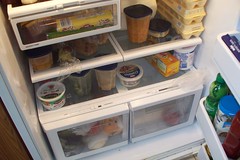This is the third in a series of what to do when you discover you can no longer eat gluten.
One of the first steps in living a gluten free life is identifying the foods in your house that you no longer can eat. If you are single or are in a household which will be going gluten free with you, take items you can’t eat and throw them away if they have been opened, and consider donating unopened foods to a local food bank. Otherwise, designate top shelves for gluten free items, and lower shelves for gluten containing items in your pantry if you are sharing food with someone who isn’t eating a gluten free diet.
Easily Assumed Safe Foods
Safe foods are single ingredient foods that are not processed. Raw vegetables and fruits of any variety, nuts, milk, cottage cheese, cream, and butter (real butter, not the fakes), Raw meats that have undergone no processing are also safe to keep. You can safely keep fresh eggs, cheese, dried fruits, peas, beans, pulses, rice, sugar, honey. molasses and most vinegars. Millet, buckwheat, flax seed and quinoa are safe grains. Olive oil, coconut oil are good safe oils. Other vegetable oils are gluten free as well. Baking soda and powder are also naturally gluten free.
Foods that can be safe, but need checking
- Oats are usually gluten free, but can be easily contaminated during the processing procedures. Its best to let others eat the Quaker Oats and purchase certified gluten free oats for yourself. In reality, oats of any kind can be hard on your system when you are coming off gluten and should be added in only after other symptoms have abated.
- Soy Sauce is made from wheat. The only soy sauce that is safe for celiac is called “Tamari” and is truly made from fermented soy beans.
- Sour Cream is typically safe if it is the full fat variety. Some brands of low fat/light sour cream might not be. Light sour cream and other items are sometimes thickened with food starch. Food starches are made from corn, tapioca or wheat. If it is made from wheat, by law it must say that on the label (food starch derived from wheat).
- Yogurt, many flavored yogurts contain gluten and light or non fat yogurts may contain food starch. Plain yogurt made from an organic company is typically safe (Best companies to buy plain yogurt from are Brown Cow, Dannon, Mountain High, Stoneyfield Farms, Tillamook and Turtle mountain). If you don’t like plain yogurt, remember you can mix it (thats all the yogurt companies do anyways) by adding fruit, jams or honey into your plain yogurt.
- Vinegar – Distilled vinegars are safe, as well as cider or apple vinegars. Non distilled vinegars made from wine and grape are also safe. Malt vinegar is not safe, it is made from barley. Any other vinegar that is not distilled or flavored needs to be checked. If a vinegar contains protein from wheat, it will be shown in the food label, either under ingredients or in the “Might Contain” area.
- Popcorn – If you are buying just straight popcorn, the type you make at home yourself either on the stove or in a popper, that popcorn is safe. Pre-popped popcorn needs to be labeled gluten free or needs to be checked out, typically, these are made in plants that process other items that include wheat. Some microwave popcorn is also safe.
Breads and Pastas and Cross Contaminated Foods
Most breads and pastas in your house are full of gluten. Get rid of them. Safe items would be gluten free breads, and pastas that are not made from wheat (rice, corn or quinoa pasta). You also need to look at your nut butters, dairy butter, jams and sauces. Pretty much anything that someone would put a knife or spoon in and spread on a piece of bread and then put the spoon or knife in again. These are areas of cross contamination which I’ll be talking about in my next post. Many people who are gluten intolerant or celiac can become sick just from coming in contact with food which came into contact with gluten. Items like these are easily contaminated.
Processed Foods
All processed foods are suspect until proven innocent. This includes frozen items and canned foods. The more ingredients there are in an item, the more chances that there is gluten hiding in it. Not all ingredients are easily understood to be from wheat, barley or rye. Depend on a gluten free ingredient list such as the one on celiac.com or if you have an iphone, you can purchase an app (Is that Gluten Free) that helps you to easily determine which items are not gluten free.
Meats
While raw meats are gluten free, meats that are processed, smoked or preserved need to be looked at. These items which include: sausage, hot dogs, pre-made hamburger patties which may have some gluten containing fillers. Some bacon and cold cuts may have also be contaminated with gluten. Read your packages and labels carefully.
Conclusion
If you are living with others who won’t share your gluten free living, then you must take care to separate out the gluten free items from the gluten full items. Place gluten free items higher up in your pantry to avoid crumbs or other items falling on them. Clearly label your gluten free foods in both your pantry, and refrigerator. Make sure that any items that can be easily cross contaminated such as peanut butter, butter and jams are both clearly labeled and that you have your own dedicated gf products that others don’t touch.
Series
- Gluten Free Series: Discovering The Need To Be Gluten Free
- Gluten Free Series: Holidays and Gluten and Thanksgiving
- Gluten Free Series: Cleaning up your Pantry
- Gluten Free Series: Eating Out
- Gluten Free Series: Kitchen Equipment, What Can Stay, What Can Go
